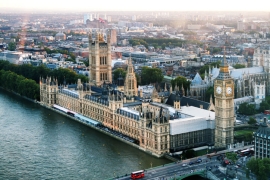
Chancellor Rachel Reeves has delivered her Spring Statement, with downgrades to near-term economic growth forecasts, increased defence spending and potential future changes to ISAs. Here we look at all the changes that might affect your finances.
What is the Spring Statement?
Let’s start at the beginning, with what the Spring Statement actually is. The Spring Statement is an annual event where the government gives an update on the state of the economy. It's not quite as big as the full Budget announcement, but it’s still important because it gives us a sense of how the economy is doing and what direction the government might take in the months ahead.
It’s kind of like a "mid-year check-up" on the country’s finances. It’s a moment for the Chancellor to address current economic conditions, highlight any major changes in government spending and provide a forecast for the future.
The Spring Statement is accompanied by a report from the Office for Budget Responsibility (OBR), which is an independent organisation responsible for checking the government’s sums and making its own forecasts.
Unlike the full Budget, which might introduce new taxes or spending measures, the Spring Statement is more about tweaking existing policies or providing updates on areas like tax receipts or how the public finances are holding up.
Whether you’re a business owner, a worker, or just someone who wants to understand where the economy is headed, it’s a key moment to pay attention to. The decisions can affect everything from your paycheck to the cost of living.
What were the main economic updates?
All eyes were on the OBR’s forecasts for UK growth, measured by GDP. As expected, it slashed the growth forecast for this year in half – saying that UK GDP will grow by just 1% this year (it had forecast growth of 2% at the October 2024 Budget). However, the outlook further out was rosier, with average growth hitting 1.8% a year over the rest of the decade.
It’s a similar story with inflation. In the short term, it’s expected to spike but in the longer term it will be back at target. The CPI measure of inflation is forecast to peak at 3.8% this year, thanks to rising bills and energy costs. But from next year it drops back down to the 2% that the Bank of England targets.
One thing that’s important to note: all of these are just forecasts and not what will actually happen.
Equally, those forecasts could change depending on many varied factors. In fact, the OBR says there are lots of risks to its forecasts, including trade wars ending in bigger tariffs, UK productivity growth failing to appear or an increase in interest rates. As an example, the report states that if a Trump trade war led to increased tariffs, it could reduce UK GDP by up to 1%.
The Chancellor said that on average household will be £500 a year better off because of the improved economic forecasts – but crucially this doesn’t hit until 2029. In the interim, the OBR estimates that the amount of tax the UK government is taking in, relative to the overall economy, will hit its highest level since World War Two. That’s due to a combination of an increase in employer National Insurance, and frozen tax bands and tax-free allowances.
What else was announced?
It had been widely reported that the government was planning to make changes to the welfare system, and these changes were confirmed in the Spring Statement.
The government heralded planning reforms as a key booster of UK growth. It said that by relaxing planning rules to boost housebuilding, it will add to UK GDP but doesn’t come with a huge price tag.
It also announced a much-trailed increase in defence spending, rising to 2.5% of GDP by 2027. Some of this money will come by reducing overseas aid to 0.3% of national income.
Was there anything announced on ISAs?
There were rumours the government would change ISAs ahead of the Spring Statement. In the end no changes or consultations materialised, but Reeves did confirm that future changes are on the agenda.
The documents alongside the Spring Statement said the government wants to get the “balance right” between cash and equities in ISAs as part of efforts to push through a retail investing revolution. It means a change to the status quo is being considered ahead of the Budget later this year, with Labour having already committed to ISA simplification and encouraging greater use of Stocks and shares ISAs during the general election campaign.
Some of the rumours ahead of the statement were based on Cash ISA allowances being scaled back to effectively shove people towards investing, but our own research shows that only one-in-five* people said they would migrate to investing in the UK stock market if the Cash ISA allowance was reduced or abolished. We’ll await more details when they come from the government.
*Based on AJ Bell research of a nationally representative sample of 1,792 Cash ISA holders conducted by Opinium on behalf of AJ Bell in March 2025.
Ways to help you invest your money
Put your money to work with our range of investment accounts. Choose from ISAs, pensions, and more.
Let us give you a hand choosing investments. From managed funds to favourite picks, we’re here to help.
Our investment experts share their knowledge on how to keep your money working hard.
Related content
- Wed, 11/06/2025 - 09:38
- Fri, 06/06/2025 - 10:32
- Wed, 04/06/2025 - 16:40
- Wed, 04/06/2025 - 10:43

